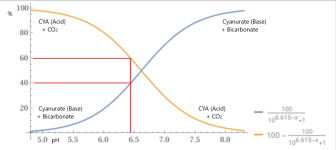If the CYA was increased by 400, then the TA would have been lowered by about 460 ppm.
If the TA started at 80 and it got lowered by 460, it would be -380 unless baking soda was added on a regular basis.
The pH could have been as low as about 2.1.
TA...............pH
0..............4.5
-2............4.4
-3............4.2
-4............4.1
-5............4.0
-6............3.9
-7............3.85
-8............3.8
-9............3.74
-10..........3.7
-20..........3.4
-30..........3.2
-40..........3.1
-50..........3.0
-60..........2.9
-70..........2.85
-80..........2.80
-90..........2.74
-100........2.7
-200........2.4
-300........2.22
-400........2.1
-500........2.0
-5,000.....1.0.
-50,000....0.0
-500,000..-1.0
He is telling me he was measuring pH regularly with strips and adjusting as needed, so if I believe him, I'm not sure the pH and TA would've actually got down that far with him adjusting along the way, but of course I'll never know.
In response to some of the other comments, there have been some wise words spoken here I plan to take to heart. If you learn from your mistakes, then I'm getting a very expensive PhD during my first year of ownership, LOL. You referenced my other post above about another heater issue, and they are indirectly related. That was a couple that was using their 3" floater in their 1500 gallon in ground spa and our maintenance tech (who has since left and I'm not sure was really properly trained on pool chemistry ) wasn't the wiser about it in his visits and this couple's defence was they were only using the products that we left with them. They had a point. I'm not sure we had ever educated them or told them to use anything differently. Anyway, I placated them thinking they would stick around as long term customers and it would be worth it, but they dropped us after getting the new heater. Word to the wise, only give credit, not cash.
So to cut my losses, I brought their MT250 back and moved some of the sensors and other items to this MT400 that had been in our warehouse from before I bought the company. My service tech assured me it had seen limited use and was suitable for selling, so I sold it "as is" to this customer, but still believing it was fully functional. After purchasing it, they told me the thermal regulator wasn't working and he sent me a picture of it. It was indeed corroded and not working well. So I started to have some doubts about the history of the heater and how much it had or had not been used. When the customer then came to me a month after buying it with the leaking exchanger, I thought maybe I had unintentionally sold him a compromised unit.
Of course, now having done this testing and the great insight of
@JamesW and others, I fully believe it was the chemistry that ruined it and the heat exchanger was likely fine. Next time I'll personally do an inspection on the end tubes of the exchanger or better yet, have the customer inspect it.
This customer ended up buying a new MT125 from me, and we agreed on a split of the cost of what I sold him the MT400 for (which was a steal admittedly), so it isn't a total loss on what I sold him the used MT400 for, but it still stings.
Anyway, I might push back on the customer a little bit, or at least make him feel guilty about the deal I gave him, LOL. I'm not sure I'll get much business out of him, but maybe he'll share our name with someone else he encounters. As a new business owner, I've focused on customer satisfaction more than anything and have eaten more $$ than I should have. I just consider it a marketing expense at this stage.
But yeah, some painful and expensive lessons learned during this first year of ownership and definitely some process steps and protocols I plan on implementing moving forward.
 www.wolframalpha.com
www.wolframalpha.com



 www.wolframalpha.com
www.wolframalpha.com





